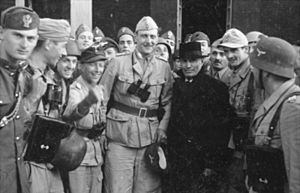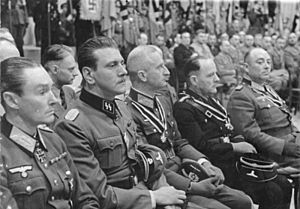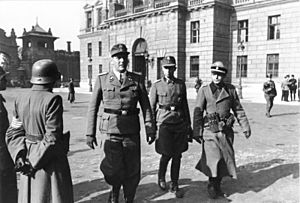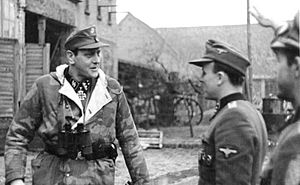Otto Skorzeny facts for kids
Quick facts for kids
Otto Skorzeny
|
|
|---|---|

Skorzeny in 1943
|
|
| Born | 12 June 1908 Vienna, Austria-Hungary |
| Died | 5 July 1975 (aged 67) Madrid, Spain |
| Allegiance |
|
| Service/ |
Schutzstaffel |
| Rank | Obersturmbannführer, intelligence agent, mercenary, assassin |
| Commands held |
|
| Battles/wars | World War II
|
| Awards | Knight's Cross of the Iron Cross with Oak Leaves |
| Other work | Civil engineer |
Otto Johann Anton Skorzeny (born June 12, 1908 – died July 5, 1975) was a famous Austrian-born German officer during World War II. He was a high-ranking officer in the Waffen-SS, a special military branch.
During the war, Skorzeny was involved in several important missions. One of his most well-known actions was rescuing the Italian leader Benito Mussolini from captivity. He also led a special operation called Operation Greif, where German soldiers dressed in enemy uniforms to create confusion behind enemy lines.
After the war, Skorzeny was accused of breaking international rules of war at the Dachau Trials in 1947, but he was found not guilty. He later escaped from a prison camp in 1948 and lived in different places before settling in Spain. He also worked as a military advisor for leaders in Egypt and Argentina. Some reports even suggest he worked for the Israeli intelligence agency, Mossad. Skorzeny passed away from lung cancer in Madrid, Spain, when he was 67 years old.
Contents
Early Life and Education
Otto Skorzeny was born in Vienna, Austria, into a family with a long history of military service. His family name, Skorzeny, comes from Poland.
Besides speaking German, he was also very good at French and knew some English. When he was a teenager, he once complained to his father about their simple lifestyle. His father told him that it was good to learn to live without many things and not get used to an easy life.
Skorzeny was a skilled fencer when he studied at the Technical University of Vienna. He took part in fifteen fencing duels. In one of these duels, he got a wound on his cheek that left a noticeable scar. This type of scar was common in academic fencing and was called a Schmiss.
In May 1932, Skorzeny joined the Austrian Nazi organization. He became a member of the Austrian branch of the Nazi Sturmabteilung (SA) in February 1934. He was a very confident person. Skorzeny played a small part in the Anschluss on March 12, 1938. He later said that he saved the Austrian President Wilhelm Miklas from being shot by other Austrian Nazis during this time.
Joining the War
After the invasion of Poland in 1939, Skorzeny, who was a civil engineer, wanted to join the German Air Force. However, he was turned down because he was considered too tall (about 6 feet 4 inches) and too old (31 years old) for pilot training. So, he joined the Waffen-SS, which was a combat branch of the SS. He trained with Hitler's personal guard regiment.
Skorzeny fought on the Eastern Front when Germany invaded the Soviet Union. In October 1941, he was in charge of a special group of German forces during the Battle of Moscow. His job was to capture important buildings in Moscow before they could be destroyed. He was also ordered to capture the locks of the Moscow Canal because Hitler wanted to flood Moscow. However, these missions were canceled because the German forces could not capture the Soviet capital.
In January 1942, Skorzeny was injured by shrapnel in the back of his head. He was sent away from the front lines for treatment. He had already received the Iron Cross, Second Class for his bravery in battle. While recovering, he worked in Berlin and developed his ideas about special commando warfare. He suggested creating units that would fight behind enemy lines, sometimes even wearing enemy uniforms, and carry out sabotage attacks.
In April 1943, Skorzeny was chosen to lead schools that trained agents in sabotage, spying, and special military techniques. He became the commander of a new special forces unit near Berlin, which was later renamed several times.
His unit's first mission was in mid-1943, called Operation François. Skorzeny sent a group by parachute into Iran. Their goal was to contact local tribes and encourage them to damage Allied supplies being sent to the Soviet Union. However, this mission was not successful.
Skorzeny's Famous Operations
Skorzeny was involved in many daring operations during the war:
- Operation François: This involved working with local fighters in Iran.
- Operation Oak (September 1943): This was the famous rescue of Italian leader Benito Mussolini.
- Operation Long Jump: This was an alleged plan to assassinate the "Big Three" leaders (Stalin, Churchill, and Roosevelt) during a meeting in Tehran in 1943. Skorzeny denied this operation ever existed.
- Operation Knight's Leap (May 1944): An attempt to capture Josip Broz Tito, the leader of the Yugoslav resistance.
- Operation Panzerfaust (October 1944): This involved kidnapping the son of the Hungarian leader to force his father to resign.
- Operation Greif (December 1944): A special operation where German soldiers wore enemy uniforms to cause confusion during the Battle of the Bulge.
The Rescue of Mussolini
In July 1943, after the Allies invaded Sicily, the Italian leader Benito Mussolini was arrested. Hitler ordered military operations to free Mussolini. He gave similar orders to different German military groups, including Skorzeny's unit and paratroopers led by General Kurt Student.
Mussolini was moved to different places by his captors. Skorzeny used intercepted radio messages and information from spies to find out that Mussolini was being held at the Campo Imperatore Hotel. This hotel was a ski resort high in the Apennine Mountains of Italy.
On September 12, 1943, Skorzeny and 16 of his SS soldiers joined paratroopers for a risky glider mission to rescue Mussolini. Ten gliders, each carrying soldiers and a pilot, took off from an air base near Rome. Skorzeny's gliders arrived first over the target. Meanwhile, other paratroopers captured the cable car station leading to the hotel.
At 2:05 PM, the gliders landed on the mountain near the hotel. Only one glider crashed, causing some injuries. The paratroopers and Skorzeny's special soldiers quickly took over Mussolini's guards without firing a single shot. This was partly because a German general who flew with Skorzeny told the guards to surrender. Ten minutes after the mission began, Mussolini left the hotel with the German soldiers.
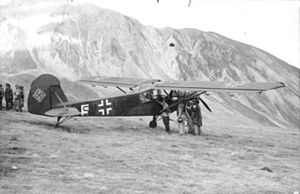
Mussolini was then flown out by a small Fieseler Fi 156 Storch plane. Even though the plane was overloaded, Skorzeny insisted on going with Mussolini, which made the flight even more dangerous. After a very risky but successful takeoff, they flew to another air base and then immediately continued to Vienna. The next day, Mussolini met Hitler.
Even though paratrooper officers led the landing at Campo Imperatore, Skorzeny made sure he was seen with Mussolini in front of the cameras. Because of this, Skorzeny and his special forces unit received most of the credit for the operation, which was a big propaganda win for the SS.
Operation Long Jump: The Alleged Plot
"Operation Long Jump" was the supposed name for a plan to assassinate the "Big Three" leaders – Joseph Stalin, Winston Churchill, and Franklin D. Roosevelt – during their meeting at the Tehran Conference in 1943. It was said that Hitler gave this mission to Ernst Kaltenbrunner, who then gave it to Skorzeny.
The Soviet Union claimed they learned about this plot from their spies. They said their agents found out the Nazis knew the meeting's time and place because they had cracked a US naval code. According to the Soviets, the assassination plot was stopped after they found the German spies in Iran, which forced Skorzeny to cancel the mission.
After the Tehran Conference, the British and Americans did not believe this story. They thought it was Soviet propaganda. Skorzeny himself supported this view in his books written after the war. He said that no such operation ever existed. He claimed that the story was made up by the Soviets, and his name was used to make the story sound more believable because he was known as a famous SS commando.
Raid on Drvar
In early 1944, Skorzeny's special unit was renamed and he remained its commander. They were assigned to "Operation Rösselsprung," also known as the Raid on Drvar. This was a commando operation aimed at capturing Marshal Josip Broz Tito, the commander of the Yugoslav resistance. Tito led the Yugoslav Partisans from his headquarters near the town of Drvar in Bosnia.
Hitler knew Tito was getting support from the Allies. He believed that capturing or killing Tito would hurt the Allied efforts and boost the morale of Axis forces. Skorzeny helped plan "Rösselsprung" and was supposed to lead it. However, he argued against carrying it out after he found out that German agents had accidentally revealed the operation's plans.
Despite Skorzeny's warnings, "Rösselsprung" went ahead, but it was a complete failure. The first group of paratroopers landed in an open area and many were quickly shot by Tito's guards. The second group of paratroopers missed their target. Tito had already escaped through a hidden trail behind his cave headquarters. Meanwhile, a Partisan brigade arrived and attacked the German paratroopers, causing many casualties.
Hungary and Operation Panzerfaust
In October 1944, Hitler sent Skorzeny to Hungary. This was because Hitler heard that the Hungarian leader, Admiral Miklós Horthy, was secretly talking with the Soviet Army. If Hungary surrendered, it would cut off a million German troops fighting in the Balkans.
Skorzeny carried out a daring mission called Operation Panzerfaust. He kidnapped Horthy's son, Miklós Horthy Jr., which forced his father to resign as the head of state. A new government that supported the Nazis was then put in charge in Hungary. This successful operation led to Skorzeny being promoted to a higher rank.
Operation Greif and the German Defeat
As part of the German attack in the Ardennes in late 1944, known as the Battle of the Bulge, Skorzeny's English-speaking troops were given a special task. They were to go behind American lines, disguised in American uniforms, to create confusion and help the German attack. Skorzeny led a special unit for this mission, called the Panzer Brigade 150.
About two dozen German soldiers, mostly in captured American Jeeps and American uniforms, were part of Operation Greif. They were supposed to enter American lines early in the battle to cause disorder. Skorzeny knew that if his men were caught wearing U.S. uniforms, they could be executed as spies under the rules of war. This was a big concern.
A few of his men were captured and spread a rumor that Skorzeny himself was leading a raid on Paris to kill or capture General Dwight D. Eisenhower. Eisenhower was not happy about this and had to spend Christmas 1944 in isolation for safety. Eisenhower then ordered a huge search for Skorzeny, with "Wanted" posters showing his description and photo. In total, twenty-three of Skorzeny's men were captured behind American lines, and sixteen were executed as spies for breaking the rules of war by wearing enemy uniforms.
In February 1945, Skorzeny acted as a major general, commanding about 5,000 troops during the defense of the Schwedt Bridgehead on the River Oder. On March 17, he was ordered to destroy the last remaining intact bridge across the Rhine at Remagen, which had been captured by the Allies. However, the bridge collapsed that same day. Hitler awarded him one of Germany's highest military honors, the Oak Leaves to the Knight's Cross.
After the War
Dachau Trials

Skorzeny was held for two years before being tried as a war criminal at the Dachau trials in 1947. He was accused of breaking the rules of war during the Battle of the Bulge. He and nine other officers were tried before a US military court in Dachau on August 18, 1947. They faced charges of improperly using US military symbols, stealing US uniforms, and stealing Red Cross parcels from US prisoners of war.
The trial lasted over three weeks. The charge of stealing Red Cross parcels was dropped because there was not enough evidence. Skorzeny admitted that he ordered his men to wear US uniforms. However, his defense argued that as long as enemy uniforms were taken off before combat, such a tactic was a fair trick in war.
On the last day of the trial, September 9, a former British agent named F. F. E. Yeo-Thomas spoke in Skorzeny's defense. He said that the Western Allies had also thought about doing similar "false flag" operations. The court then found the ten defendants not guilty. The court made a difference between fighting in enemy uniforms and using them for other purposes like deception. They could not prove that Skorzeny had ordered his men to actually fight while wearing US uniforms.
Escape from Prison
Skorzeny was held in a prison camp in Darmstadt, waiting for a decision from a court that would determine if he was a Nazi. On July 27, 1948, he escaped from the camp. Three former SS officers, dressed in US Military Police uniforms, entered the camp and claimed they were ordered to take Skorzeny to a legal hearing. Skorzeny later said that US authorities helped him escape and provided the uniforms.
Skorzeny hid at a farm in Bavaria for about 18 months. During this time, he was in contact with Reinhard Gehlen, a former German intelligence officer. Skorzeny was photographed at a café in Paris in February 1950. The photo appeared in the French newspapers the next day, causing him to move to Salzburg. He then moved to Madrid, Spain, with the help of a special passport. There, he started a small engineering business.
Military Advisor

In 1952, General Mohammed Naguib took over Egypt. In 1953, Skorzeny was sent to Egypt by former General Reinhard Gehlen to be Naguib's military advisor. Skorzeny hired former German officers to train the Egyptian army. He also trained Arab volunteers in commando tactics, possibly for use against British troops. Some Palestinian refugees also received commando training, and Skorzeny planned their raids into Israel in 1953–1954. One of these Palestinians was Yasser Arafat. Skorzeny continued to advise Egyptian President Gamal Abdel Nasser.
Some writers say that Skorzeny traveled between Spain and Argentina. There, he reportedly advised President Juan Perón and worked as a bodyguard for Eva Perón. He was also said to have a dream of a "Fourth Reich" based in Latin America.
Alleged Work for Mossad
In 1989, an Israeli magazine claimed that Skorzeny was recruited by Mossad, the Israeli intelligence agency, in 1963. The article said he was hired to get information on German scientists who were helping Egypt develop rockets that could be used against Israel. A major Israeli newspaper later confirmed this story with a senior Mossad source. Former Mossad head Isser Harel also confirmed that former Nazis were recruited to gather intelligence on Arab countries.
Some sources say that Skorzeny agreed to help Mossad only if he was removed from a list of wanted war criminals, but this was refused. Other reports suggest he was recruited after Mossad visited his home in Spain, where he expected to be killed. After training in Israel, his rumored work for Mossad included assassinating a German rocket scientist working for Egypt and sending a letter bomb that killed five Egyptians at a rocket site. He also allegedly provided names and addresses of German scientists and companies supplying military equipment to Egypt.
No confirmed reason explains why Skorzeny would work with Israel. He might have enjoyed the adventure and danger, or he might have feared being assassinated by Mossad. However, a German magazine article in 2018 raised doubts about Skorzeny's involvement in the scientist's death, stating that the Mossad chief ordered the murder.
Other Activities
Like many former Nazis, Skorzeny was officially "denazified" in 1952 by a West German board. This meant he could travel from Spain to other Western countries using a special passport for stateless people. He visited Ireland in 1957 and 1958. In 1958, he got an Austrian passport, and in 1959, he bought a large farm in Ireland. Although he could not be denied entry without a good reason, the Irish government did not give him a residency visa, so he had to limit his stays to six weeks at a time. He was also watched by Irish military intelligence. He rarely visited after 1963 and sold his farm in 1971. Because he was very tall (6 feet 4 inches) and had his famous scar, he was easily recognized. This caused newspapers in England and Ireland to wonder why he was in Ireland. One local person in Ireland remembered Skorzeny as someone who "wasn't particularly friendly and didn't really mix with local people." Skorzeny also owned property in Majorca, Spain.
In the 1960s, Skorzeny started a group called the Paladin Group. He imagined it as an international group of special operations personnel who would work between military actions and political spying. Based near Alicante, Spain, the Paladin Group specialized in arming and training guerrilla fighters. Some of its members were hired by the Spanish government to fight against a separatist group called ETA.
Skorzeny was also a founder and advisor to the leadership of a Spanish neo-Nazi group called CEDADE, which was created in 1966.
It is rumored that Skorzeny, using fake names, set up a secret organization called Die Spinne (English: "The Spider"). This group supposedly helped as many as 600 former SS men escape from Germany to Spain, Argentina, and other countries. Over the years, Skorzeny and his network of helpers are said to have gained a lot of influence in Europe and Latin America.
Death and Legacy
In 1970, doctors found a cancerous tumor on Skorzeny's spine. Two tumors were later removed in a hospital in Hamburg, which left him temporarily unable to move. Otto Skorzeny died from lung cancer on July 5, 1975, in Madrid. He was 67 years old. He never publicly spoke against Nazism during his life.
He had a Roman Catholic funeral service in Madrid on August 7, 1975. His body was then cremated. His ashes were later taken to Vienna and buried in the Skorzeny family plot at Döbling Cemetery. His funerals in Madrid and Vienna were attended by former SS colleagues. Some of them gave the Nazi salute and sang some of Hitler's favorite songs.
Skorzeny's life has been shown in several television dramas and films, including Mussolini: The Untold Story, Mussolini and I, and Walking with the Enemy (2014).
Awards
- Iron Cross (1939) Second Class (August 26, 1941) & First Class (September 12, 1943)
- Knights Cross of the Iron Cross, September 13, 1943; Oak Leaves, April 9, 1945 (826th)
See also
 In Spanish: Otto Skorzeny para niños
In Spanish: Otto Skorzeny para niños
Images for kids



